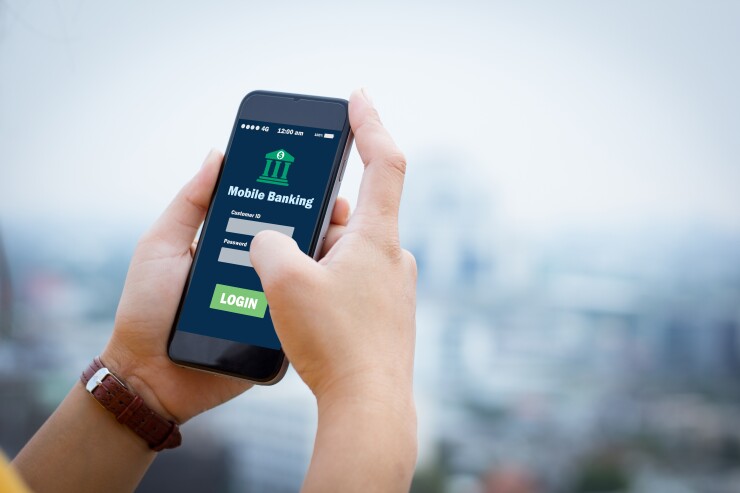The ability to
In fact, the most important components in a mobile app, including informational activities such as finding account information, transactional activities such as money transfers and service activities such as setting alerts, have not changed in the past few years, said Peter Wannemacher, principal analyst in digital banking at consulting firm Forrester.
"What has changed is which mobile app features have risen, or are rising" to the level customers expect, he said, such as card management or peer-to-peer payments.
A bank's mobile app won't necessarily make or break its relationship with customers. But the quality of the app influences whether the customer will trust this financial institution and, in turn, how deep that relationship will run.
"The majority of bank customers have a secondary account somewhere, particularly those under age 40," said Jennifer White, senior director of banking and payments intelligence at J.D. Power. A better mobile app can be one factor that tugs them toward one bank over another.
Maintaining a successful mobile app is partly about staying ahead of the curve in terms of which features customers want or expect — even if it's only a portion of the customer base, because one size does not fit all in consumer banking — as well as ensuring the more "basic" components are visually appealing, self-evident and easily navigable. It also means keeping an eye on which features have moved from mildly important to vital in recent years.
The military-focused bank and insurance company has added more personalization and a search tool.
White finds that the two key elements customers look for are ease of use for core transactional needs, such as checking a balance and depositing a check, and personal finance management tools.
"You would think every bank today would be performing highly at those," said White. Yet satisfaction with transactional experiences is declining at the aggregate, she said. There are several reasons for those declines, including shifting expectations on the part of consumers and their higher understanding of digital functionality.
"It is not that banks are 'just not getting it' but the list of digital improvement goals is long and challenging to keep pace with," including aggregating information and delivering advanced tools such as generative artificial intelligence, said White. "The customer's voice is clear, however, that while focusing on these massive needs, ensuring the core functionality is easy to use, intuitive, and seamless is table stakes, and many banks need to improve."
While the large banks have gone "all in" on personal finance management tools, White finds that smaller banks may have one or two good features, but do not meet the four types she thinks are ideal: a spend analysis, a
Another area where quality varies is alerts and notifications, said Susan Foulds, managing director of Keynova Group. She finds that several banks she studies don't have real-time balance alerts.
"You would expect that would be pretty basic," she said.
Wannemacher finds that peer-to-peer payments are more essential than they were five years ago, and that the granularity of transaction data in the mobile app has evolved. "It's useful to see the location of the merchant," he said.
Another big one is card management.
"Pre-pandemic, the best mobile banking apps had some level of card management but almost no one had what's available today, with your ability to instantly freeze or unfreeze or set transaction limits, to activate cards, to report lost or stolen cards," said Wannemacher. Foulds notes that banks still have room for growth in this area, by enabling more controls such as the type of transactions or limits on spending amounts. Truist Financial in Charlotte, for example, gets as granular as letting users toggle certain transaction types on or off, including e-commerce versus online purchases, recurring purchases and different ATM activities.
One element that is rising in importance is account aggregation.
"In January 2024 is it expected by the majority of bank customers? No, we don't see that," said Wannemacher. "But it's rising so fast that banks should strategize assuming aggregation is expected."
J.D. Power has seen a connection between use of virtual assistants and engagement with personal finance tools in the mobile app.
"Which comes first? I don't know," said White. "I just know once you use a virtual assistant or personal finance management tool, you are more likely to be engaged with your bank on a regular basis and then see value in that engagement."
Virtual assistants can also be used to satisfy another element customers want in their bank apps, even if they aren't explicitly saying it: the ability to search the app using conversational language or keywords. "Erica works quite well at helping you find stuff," said Wannemacher. It doesn't matter that Erica doesn't act like a traditional search bar.
Wannemacher also classifies some mobile app components as pleasant surprises for customers that will differentiate the app, even if users won't be upset by their absence.
This includes
For goal-related features, Foulds recommends they be easily visible in the app so they stay top of mind. The most sophisticated ones will automatically skip a transfer from checking to savings if a customer's balance is too low.
Foulds also prizes user-facing security elements, or visual features that illustrate the security strengths of a customer's account and dispenses tips to secure them further. For instance,
One aspect of the mobile app that sounds simple, but may be overlooked, is providing clear, accessible information on account rates and fees that don't require a customer to hunt them down in a PDF. For instance, in Capital One's mobile app, a list of "ways to pay" includes a tag with the fees attached to cashier's checks and money wires.
"Sometimes it's those little things that make a difference," Foulds said.







